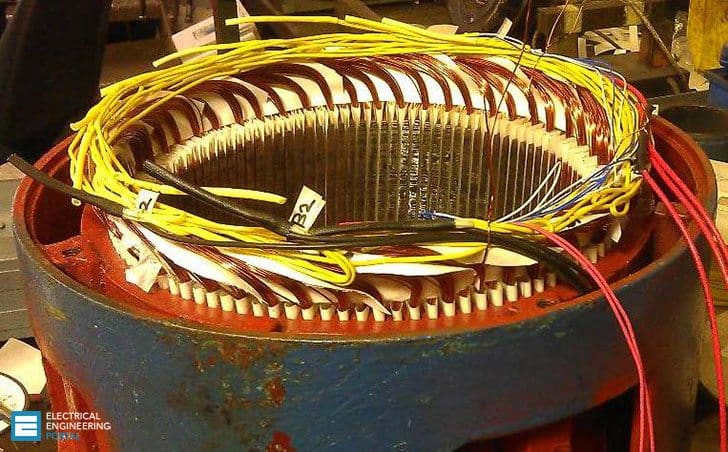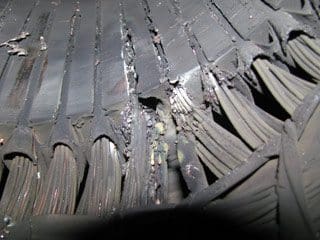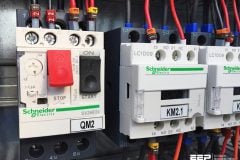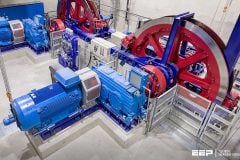Increasing Motor Efficency
Unlike an initial motor purchase where your decision is limited to procuring a standard versus a premium efficiency motor, a motor failure or burnout produces three alternatives. Your options are to rewind the failed motor, purchase a new standard-efficiency motor, or purchase an energy-efficient replacement motor.

For this scenario, motor installation labor costs are again not included as the existing motor must be removed and reinstalled anyway.
Assuming that the failed motor can be rewound, the baseline or lowest initial cost approach is to rewind the motor to its original specifications. As some older U-Frame motors were built with oversized slots, it is sometimes possible to perform a “high-efficiency” rewind and slightly increase the efficiency of the motor by adding more copper to reduce I2R losses.

If the original unit was wound with aluminum wire, it should be replaced with copper.
A motor should be rewound with the same (or larger) winding wire size and configuration. If a repair shop does not have the correct wire size in stock and uses a smaller diameter wire, stator I2R losses will increase.
While a decrease in the number of turns in a stator winding reduces the winding resistance, it also shifts the point at which the motor’s peak efficiency occurs toward higher loads and increases the motor’s mag-netic field, starting current, locked rotor, and maximum torque. A change from 10 to 9 turns will increase the starting current by 23 percent, which can cause problems in the electrical distribution and motor protection systems.
In a typical rewind, the stator is heated to a temperature high enough to bum out its winding insulation. The windings are then removed and replaced.
The resulting higher temperatures increase losses by changing the electrical characteristics of the motor’s core.
For both standard and high-efficiency motors, the rewind shop should follow the motor manufacturers’ rec-ommended burnout temperature specifications.
When stripping out the old windings, it is essential to keep the stator core below 700°F. If the stator core gets too hot, the insulation between the stator laminations will break down, increasing eddy current losses and lowering the motor’s operating efficiency.
After being damaged, the lamination insulation cannot be repaired nor the efficiency loss restored without under going a major repair such as restacking the iron. The motor also becomes less reliable. Insulation removal techniques vary between rewind shops and should be investigated prior to deciding where to have the motor rewound.
Some shops have core loss testers and can screen motors determine if they are repairable prior to stripping. The repair shop should also determine and eliminate the cause for a motor’s failure.
Aside from proper strip-ping procedures, the motor owner should ensure that the rewind shop does the following:
- Uses proper methods of cleaning
- Installs Class F or better insulation
- Uses phase insulation between all phase junctions
- Uses tie and blocking methods to ensure mechanical stability
- Brazes rather than crimps connections
- Uses proper lead wire and connection lugs
- Applies a proper varnish treatment
As motor design characteristics (such as slot geometry and configuration), failure modes, rewind practices, and materials specifications and treatments vary, it is impossible to identify a “typical” rewind cost for a motor with a given horsepower, speed, and enclosure.
Motor efficiency losses after rewinds also vary considerably. While dynamometer tests conducted by the Electrical Apparatus Service Association indicate that new motors, when properly stripped and rewound, can be restored to their original efficiency, field tests on motors from a variety of manufacturing plants indicate that losses are typically higher in motors that have been rewound-perhaps because of thermal shock suffered during the motor failure.
An analysis of core loss tests taken over a 1 year period in General Electric repair facilities indicates that average core losses are 32 percent higher than normal for motors that had been previously rewound. General Electric also conducted a test of 27 rewound motors in the 3- to 150-hp size range.
The test indicates that total losses increased by 18 percent for motors that have been rewound compared to those that have not been rewound.
Rewound motors can exhibit severe efficiency losses, especially if they were rewound more than 15 years ago or have been rewound several times. Rewind losses of 5 percent or more are possible.
When should a energy-efficient motor be purchased in lieu of rewinding a failed standard-efficiency motor?
This decision is quite complicated as it depends on such variables as the rewind cost, expected rewind loss, energy-efficient motor purchase price, motor horse-power and efficiency, load factor, annual operating hours, electricity price, and simple payback criteria.
At least some of the time, rewinding will be the best decision. The prospects for a good rewind are greatly im-proved if you keep good records on your motors and provide them to the repair shop. Repair shops often can’t get complete specifications from manufacturers.
They must “reverse engineer” motors, counting winding turns, noting slot patterns, measuring wire size, etc. before removing old windings. Sometimes a motor has failed repeatedly in the past because of a previous non-standard rewind.
The same error can be repeated unless the shop knows the motor is a “repeat offender” and di-agnoses the problem. Similarly, a motor is sometimes subjected to unusual service requirements, e.g., frequent starts, dirty environment, low voltage.
Most shops know how to modify original specifications to adjust to such conditions.
Rules Of Thumb
Here are several rewind “rules of thumb”:
- Always use a qualified rewind shop. A quality rewind can maintain original motor efficiency. However, if a motor core has been damaged or the rewind shop is careless, significant losses can occur.
- Motors less than 100 hp in size and more than 15 years old (especially previously rewound motors) often have efficiencies significantly lower then cur-rent models. It is usually best to replace them.
- If the rewind cost exceeds 65 percent of a new energy-efficient motor price, buy the new motor. In-creased reliability and efficiency should quickly recover the price premium.
- If your energy costs average $0.03/kWh or more, and a motor is operated for at least 4,000 hour per year, an energy-efficient motor is a worthwhile investment. The higher purchase price will usually be repaid through energy savings within 2 years.
Here is a chart to help decide when to select an energy efficient motor:
Choose a new energy-efficient motor if:
| Your energy costs are: | Annual hours of use equals or exceeds: |
| $0.02/kWh | 6,000 |
| $0.03/kWh | 4,000 |
| $0.04/kWh | 3,000 |
| $0.05/kWh | 2,000 |
Table 1 indicates how breakeven rewind costs vary with respect to motor operating hours and simple payback criteria. The breakeven cost is expressed as a percentage of a replacement energy-efficient motor price.
A new energy-efficient motor should be purchased if the rewind cost exceeds the stated breakeven point. Table 1 may be used for NEMA Design B motors in the 5- to 125-hp size range.
Assumptions used in the preparation of this table include an expected 2 percent loss in an average standard motor efficiency due to rewinding, replacement with an average energy-efficient motor operated at a 75 percent load factor, and a list price discount rate of 65 percent.
Table 1 – Breakeven Rewind Cost as a Percentage of an Energy-Efficient Motor Price
| Simple Payback Criteria (Years) | Annual Operating Hours | ||
| 8,000 | 6,000 | 3,000 | |
| 3 | 30% | 45% | 65% |
| 2 | 5% | 65% | 70% |
You can easily complete a cost-effectiveness analysis for a rewinding. If you can be assured that the past and prospective rewinds comply with all the foregoing recommended practices, the original efficiency could be maintained. Otherwise, two points should be subtracted from your standard motor efficiency to reflect expected rewind losses.
Annual energy and cost savings are determined by inputting the appropriate energy-efficient motor performance, operating hours, electricity price, and load factor into Equations below. The incremental cost of procuring the premium-efficiency unit is the quoted price for the new motor less the rewind price and any utility rebate.

Where:
hp = Motor nameplate rating
L = Load factor or percentage of full operating load
Estd = Standard motor efficiency under actual load conditions
EHE = Energy-efficient motor efficiency under actual load conditions as
The simple payback for the energy-efficient motor is simply the incremental cost divided by the total annual energy conservation benefits.
Motor Rewinding Process (VIDEO)
Reference: Energy-Efficient Electric Motor Selection Handbook – Gilbert A. McCoy, Todd Litman and John G. Douglass











As someone with no knowledge in the area, I was surprised by your suggestion to rewind a unit with copper if it was first wound with aluminum. It makes sense that you want to rewind the motor with a wire that is the same size or larger than the previous one. Why do you want to replace an aluminum wire with a copper wire when rewinding and repairing? Thanks.
Because copper wire has lower resistance than aluminium
Have a 220v single phase for a paper cutter that may have a short? cuts out under load / after a few seconds from pushing the cut buttons.What options do we have?
Thanks,
Mark.
Copper wire has lower resistance than aluminium.. That’s why